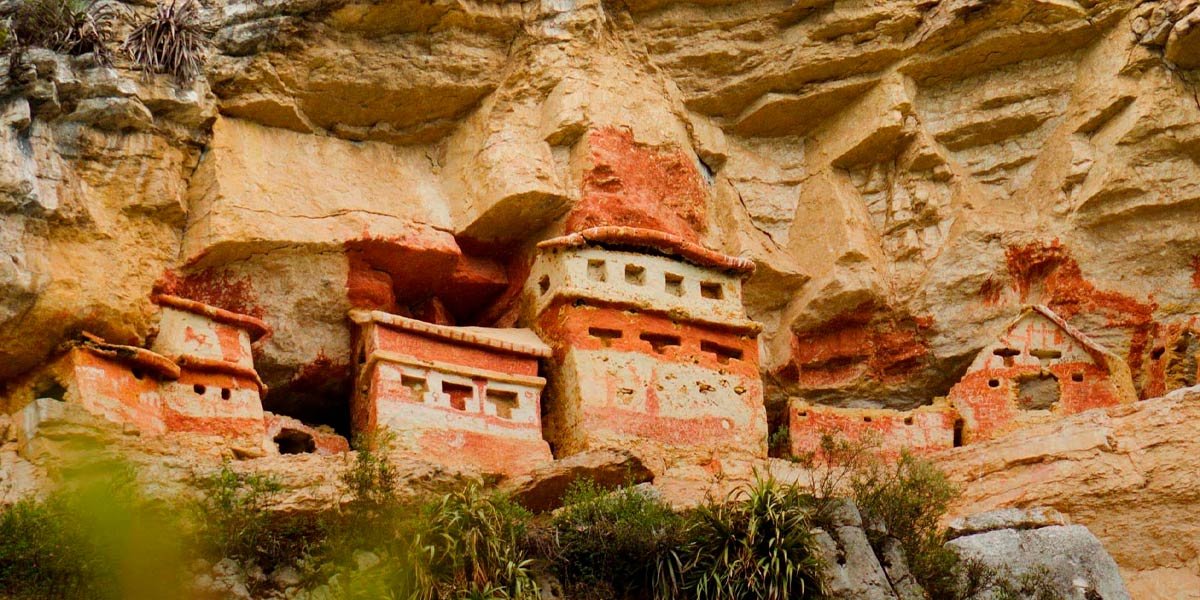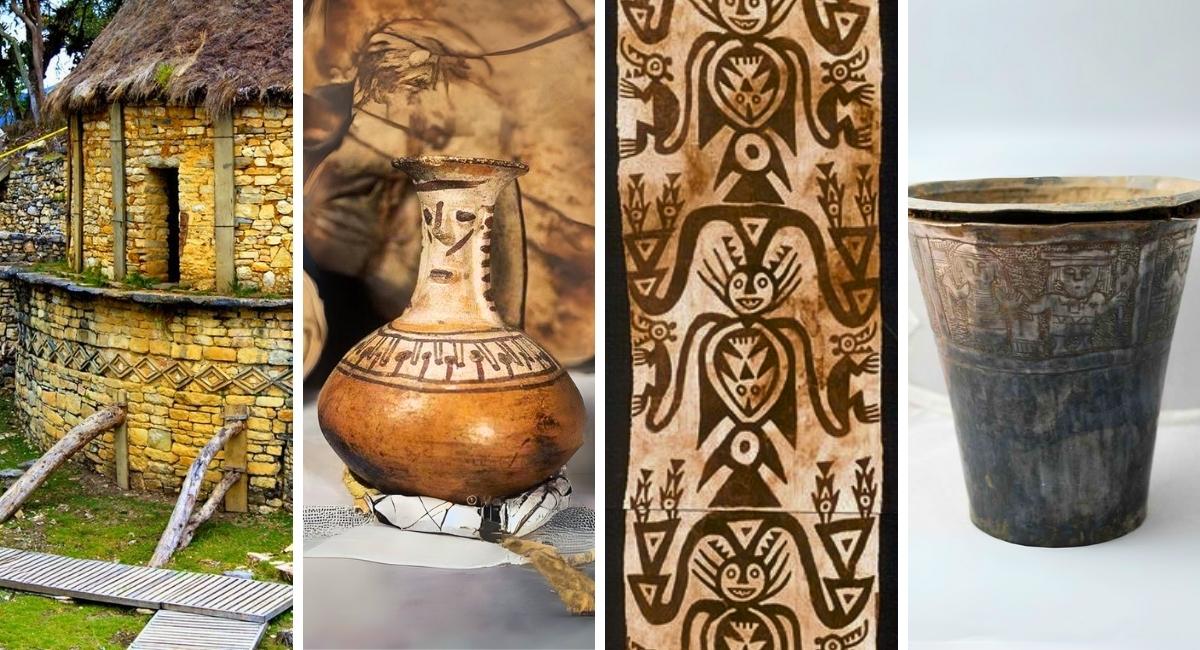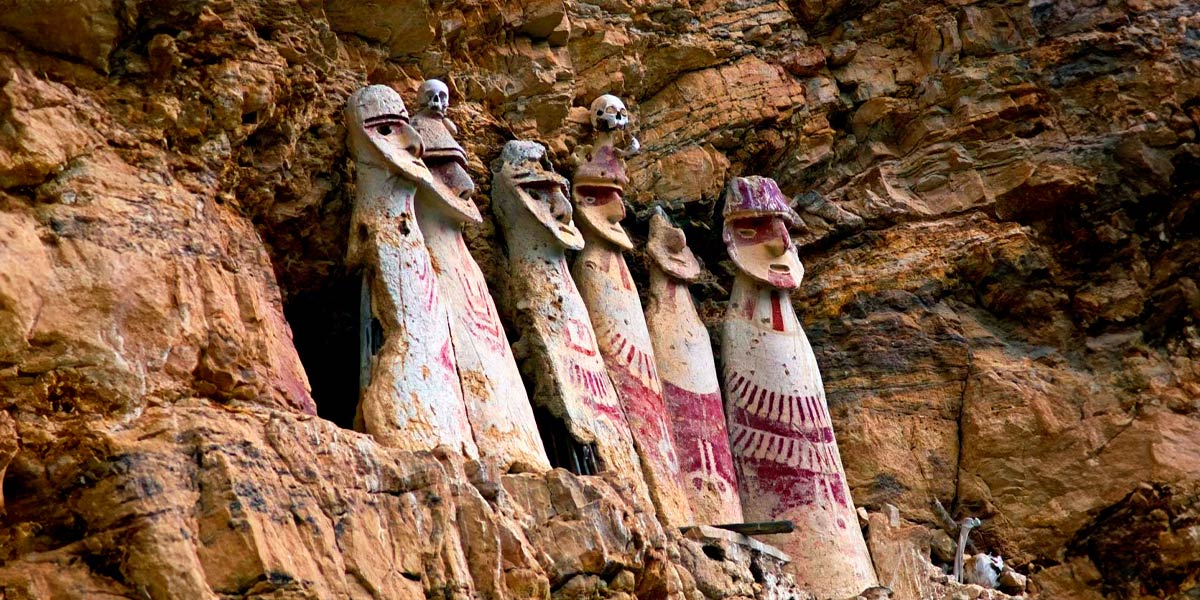The Chachapoyas Culture, known as the "warriors of the clouds", was a pre-Inca civilization that lived in the Amazonian region of the northern Peruvian Andes, between the 8th and 15th centuries. It developed in an environment of steep mountains, deep canyons, and cloud forests. The Chachapoyas were known for their impressive stone buildings, such as the Kuélap fortress, considered the largest in South America, as well as funerary complexes with sarcophagi and mausoleums unique to the Andean region.
Their culture was known for its own identity, marked by social organization, the use of stone in architecture, and a close relationship with the natural landscape. Although they were made part of the Inca Empire in the 15th century, they left a cultural and archaeological legacy that today continues to fascinate historians, archaeologists, and travelers who tour their territory in the current Amazonas region of Peru.
About Chachapoyas Culture
The Chachapoyas culture settled in the southeast of the Bracamoros, mainly on the right bank of the Marañón river. Their development was centered in the Utcubamba valley, whose name can be translated as “utcu territory” (holes or caves). From there, the Chachapoyas likely expanded south, reaching the Abiseo area, at the source of the Huallaga river, where the enigmatic citadel of Pajatén is found.
The chronicler Pedro Cieza de León left valuable references about this people, describing both their customs and their appearance:
“They are the most fair and graceful of all I have seen in the Indies that I have visited, and their women were so beautiful that, for their beauty and kindness, many deserved to belong to the Incas and be taken to the temples of the Sun. […] They and their husbands wore wool clothes and had llautos on their heads, a distinctive mark they used to be recognized everywhere.”
Discovery of the Chachapoyas Culture
Kuélap or Cuélap is an important pre-Inca archaeological site located in the northeastern Andes of Peru. On a day like today, but in 1843, Crisóstomo Nieto, judge of First Instance of Chachapoyas, discovered Kuelap, located 3 thousand meters above sea level, in Tingo, Luya province, Amazonas Region, 72 km away.
Development of the Chachapoyas culture
The Chachapoyas culture developed between 800 AD. and 1570 AD. in northeastern Peru. It developed throughout the Amazonas region, one of the 24 departments that, in addition to the Constitutional Province of Callao, make up Peruvian territory. This is located in the northwest section of our country, in the jungle. This space is located at an intersection formed by the pass between the western Andes and the eastern jungle, most of which is covered by steep mountains and impenetrable jungles. This peculiar location is the cause of the varied climate observed in its territory.
The archaeological and excavatory studies carried out in Kuelap have determined that the inhabitants of this culture began their settlement in the Early Intermediate period, approximately in the year 400 BC, until the year 1570 AD. The architectural splendor took place in the Late Intermediate period, during the 900s AD until 1475 AD, the time when most of the structures seen today on the surface of Kuelap were built. The splendor of this culture is cut short by two very distinct stages: the Inca conquest of the region and the consequent Spanish occupation, both short and totally devastating.
Already in the year 1570, Kuélap was completely abandoned, when the then Viceroy Toledo implemented the policy of Indian reductions, this generated the displacement of indigenous communities which fled en masse from their ancestral territories to new settlements.
What did this pre-Inca culture stand out for?
-
Architecture
The constructions of the Chachapoyas culture are known for their circular layout, with raised bases, stone walls, and cornices made of flat stone slabs. The most notable architectural complexes are Olán, Yalapé, Purunllacta or “Monte Peruvia”, Congón (renamed as Gran Vilaya), Vira Vira, Pajatén, among others. However, the architectural jewel is Kuélap, an imposing fortress almost 600 meters long with walls that reach 20 meters in height, considered the largest stone construction in South America before Machu Picchu. Also, there are the Sarcófagos de Carajía, which are a unique example in the Andes: coffins of mud and stone with a human shape, placed on inaccessible cliffsCurious Fact: Each sarcophagus could measure up to 2.5 meters in height and many kept decorative paint, which shows the respect for their dead and the importance of the religious worldview. -
Ceramics
Chachapoya pottery had a utilitarian character, mainly intended for the preparation and consumption of food or drinks. Its style was simple, with basic shapes and modest decoration, which indicates that it was not a prestige item as in other Andean cultures. Most pieces were made with the coiling technique or by manual modeling of the clay.
The decorative motifs were few, but techniques such as incision, punctation, and stamping were applied. An interesting detail is that, despite their simplicity, some pieces show influences from other Andean cultures, which shows the contact and cultural exchange in the region. -
Textiles
In textile production, the Chachapoyas worked mainly with cotton and, to a lesser extent, with llama and alpaca fibers. They mainly used the backstrap loom, with which they managed to make garments of notable quality.
A key finding occurred at the Laguna de los Cóndores, where textiles used to wrap mummies in the Inca era were found, many of them surprisingly well preserved thanks to the cold and humid climate of the region. These discoveries have shown that the Chachapoyas were exquisite weavers, capable of creating complex designs that reflected both their cultural identity and Inca influence after the conquest of their territory. -
Metallurgy
Unlike other Andean cultures, the Chachapoyas did not develop a notable metallurgical tradition. Their main advances were in architecture, textiles, and pottery. This detail has led archaeologists to think that the culture prioritized using immediate natural resources, such as stone and plant or animal fibers, over the mining of minerals.
Curious Fact: Despite this apparent lack of metallurgy, some metal objects have been found in the region, which suggests they could have gotten them through trade with other cultures like the Incas or the coastal peoples.
Legacy of the Chachapoyas Culture
The Chachapoyas left a vast archaeological legacy that is reflected in impressive stone monuments. The fortress of Kuélap, known as the “Machu Picchu of the north”, stands out as one of the largest complexes in South America, with walls that exceed 20 meters in height and hundreds of circular buildings. In addition, they built unique funerary structures like the sarcophagi of Carajía and the mausoleums of Revash, considered true architectural jewels embedded in the cliffs of the mountains.
The Chachapoya legacy is not limited to these monuments. The region also offers other attractions of great cultural and natural value, such as the Lake of the Condors, where mummies were found in a perfect state of preservation; the Leymebamba Museum, which protects more than 200 funerary bundles; and the famous Gocta waterfall, one of the tallest in the world, which complements the scenic richness of the Chachapoya territory.
A key aspect of this culture was the deep respect for their dead. Their burials were divided into two main traditions: the sarcophagi of Carajía, individual tombs with an anthropomorphic shape, and the mausoleums of Revash, which served as collective pantheons. Both were located on cliffs and in hard-to-reach areas, which reflects the spiritual importance and symbolic protection they gave to their ancestors.
Best Tours in Peru
Many are the routes that take you to Machu Picchu, but none is like the Inca Trail Tours, the most famous pedestrian path in the Americas. After flying from the capital of Perú, Lima, you will arrive in Cusco to walk for four days along a path through forests and dense fog, millenary stone steps and discovering the ruins of ancient fortifications and Inca cities, and all the time enjoying majestic views.
- Peru Adventure Holidays
- Enigmatic Peru
- Peru Full of Adventures
- Peru Luxury Travel
- Peruvian Highlands
- Discover Peru
Inca Trail, Machu Picchu and more
- Salcantay Trek Peru to Machu Picchu 5 days
- Palcoyo Mountain Tour
- Cusco to Manu Tour
- Humantay Lake Day Trip
- Huchuy Qosqo Day Hike
- Llactapata Inca Trail to Machu Picchu
- Apurimac River Rafting
- Vilcabamba Trek to Machu Picchu
- Inti Raymi and Machu Picchu Tour
If you want to visit Machu Picchu, we recommend you to book your Machu Picchu Ticket in advance, so you will enjoy your Vacation in Machu Picchu without any problem.









